DINOSAURS: Success cases in the media landscape
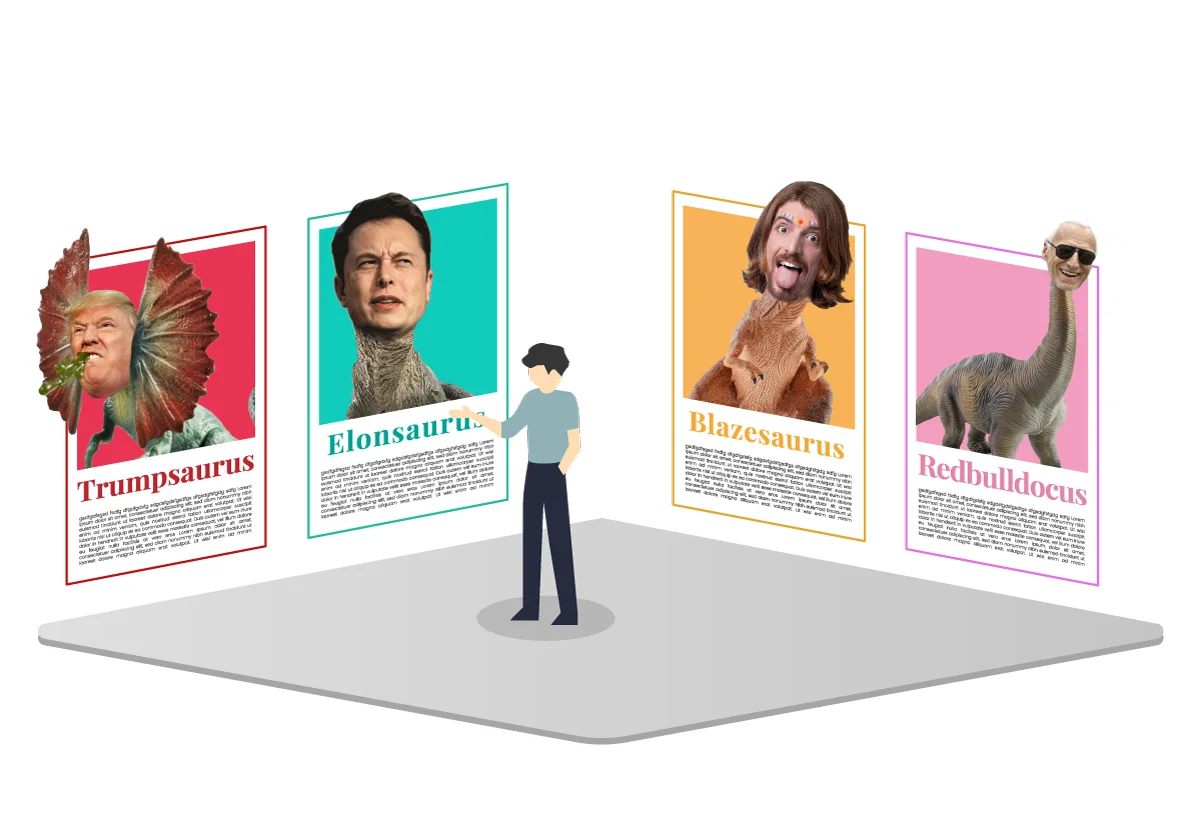
In the following pages, we have sketched out 8 dinosaurs built on major success cases in the media landscape of this century. We have translated these examples into the language of the News-Worth Canvas to make the concepts comparable, easy to understand, and applicable.
These examples are very different from one another, but they share certain patterns. That is why we call them dinosaurs. The dinosaurs described hereafter should help you understand News-Worth Dynamics and serve as a source of inspiration for your own work, as well as clarifying some of the concepts laid out in the previous pages.
New dinosaurs will no doubt emerge over time. Our goal in defining and describing these dinosaurs is to recast well-known concepts into a standardized format — the News-Worth Canvas — so that they are immediately useful in your own work.
The Elonsaurus
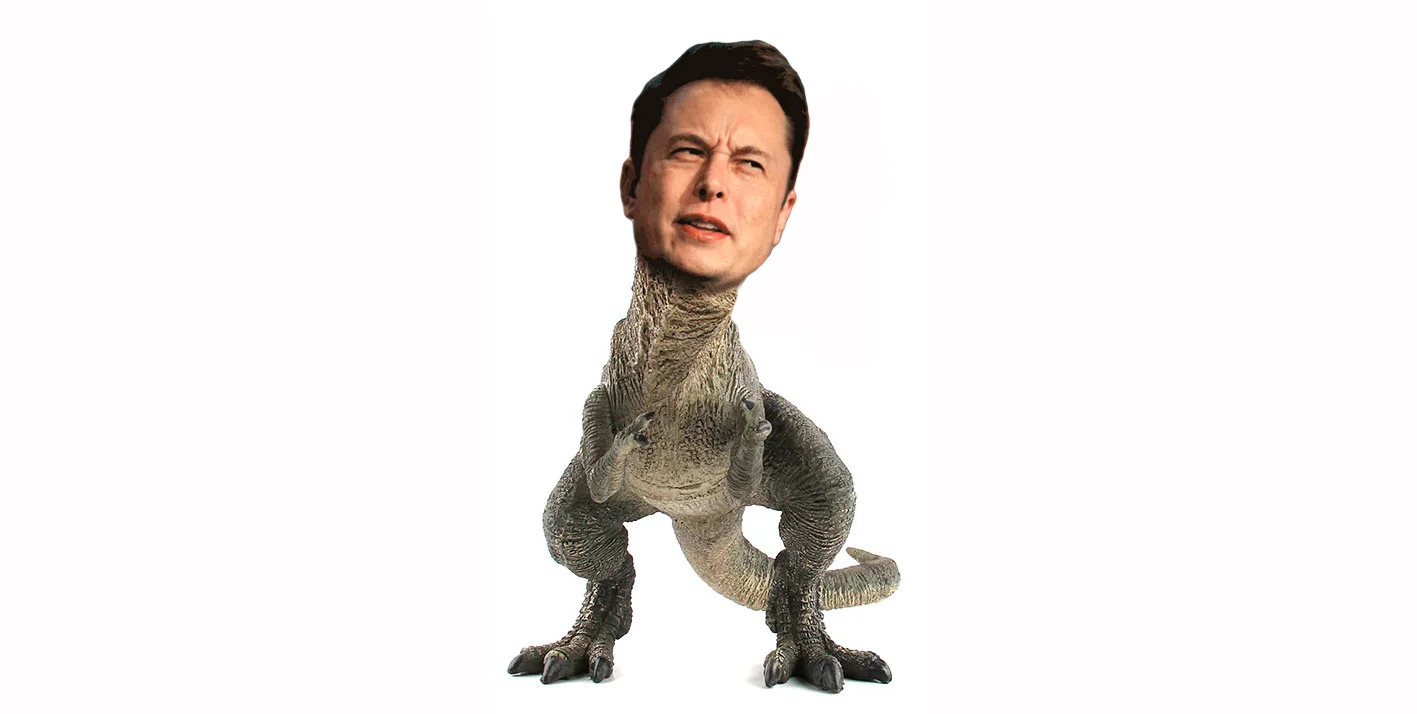
The Elonsaurus is a large carnivore that claims to do something very newsworthy, but actually delivers something else instead. Thanks to this distinctive behaviour, the Elonsaurus earns free media coverage and ends up selling a lot of the not-newsworthy stuff.
The Elonsaurus was named after the Chief Executive Office of Tesla Motor, a company with a $0 advertising policy that became successful due to media coverage. The value that investors place in the brand is reportedly based on the fact that Tesla is able to draw organic conversations and excitement surrounding their products.
When Elon Musk started Tesla, he claimed to be creating a super affordable electric car so as to help the whole world switch to electric and therefore save the planet. He was a disruptive innovator battling against the bigger old evil gas car corporations. This scenario hits many of the criteria of news-worth: it has a broad social impact, as it affects a wide range of people; there is conflict and it’s happening close to home since Tesla’s affordable electric cars could ride the streets of your town — you could easily drive one yourself.
Take a look at the story through the lens of the News-Worth Canvas:
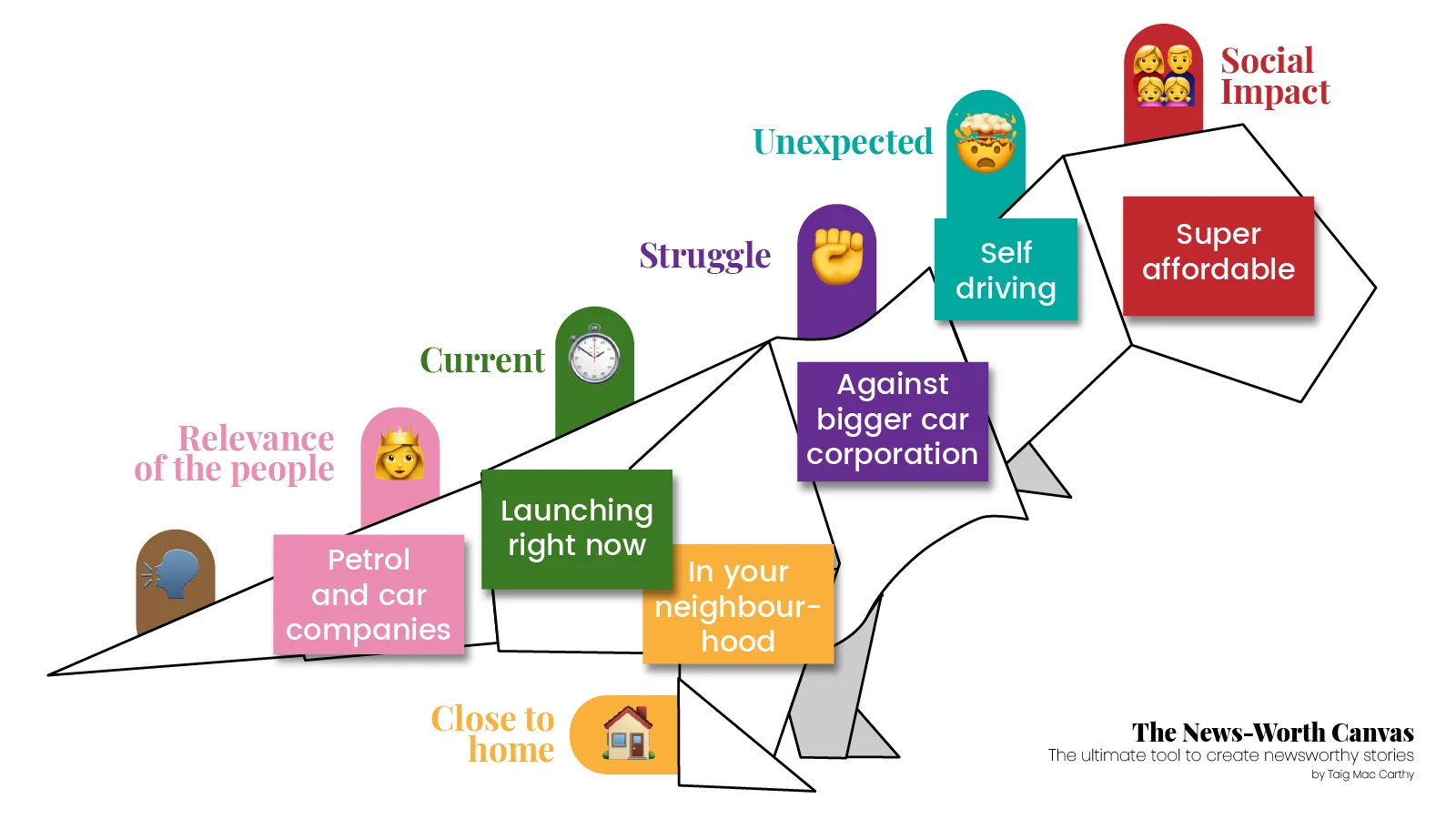
But then, Tesla delivered a high-end luxurious car instead of the mass-market affordable car they had promised. This luxurious car is awesome, yes, but it’s not newsworthy because it lacks most of the elements previously mentioned.
A fancy deluxe electric car has a far narrower social impact because it only affects wealthy people. As for conflict, now the story is about a rich white man making expensive cars for rich people, and that’s not precisely challenging the status quo. And most importantly: it’s not close to home anymore, because unless you live in Palo Alto, there are few chances you’d see one — and let’s face it: let alone afford one.
This is what the Elonsaurus is all about: claiming to be doing something newsworthy, and then capitalising on the media attention to sell something else. Does Elon Musk apply this strategy consciously to get media coverage and achieve quick growth, or does he genuinely fail at developing an affordable car? That’s not for us to judge. It could be both. The important thing is that it works.
In 2015 alone, Tesla sold 84,000 luxurious electric cars and turned themselves into a worldwide recognisable brand — with a $0 advertising policy. Indeed, the car company had no advertising team, no CMO, and no ad agency, and yet they managed to achieve quick growth in a very competitive market. That is what a dinosaur does to a marketing strategy.
Let’s take a closer look at Tesla’s advertising and marketing strategy (or lack thereof) to understand the power of a dinosaur in action.
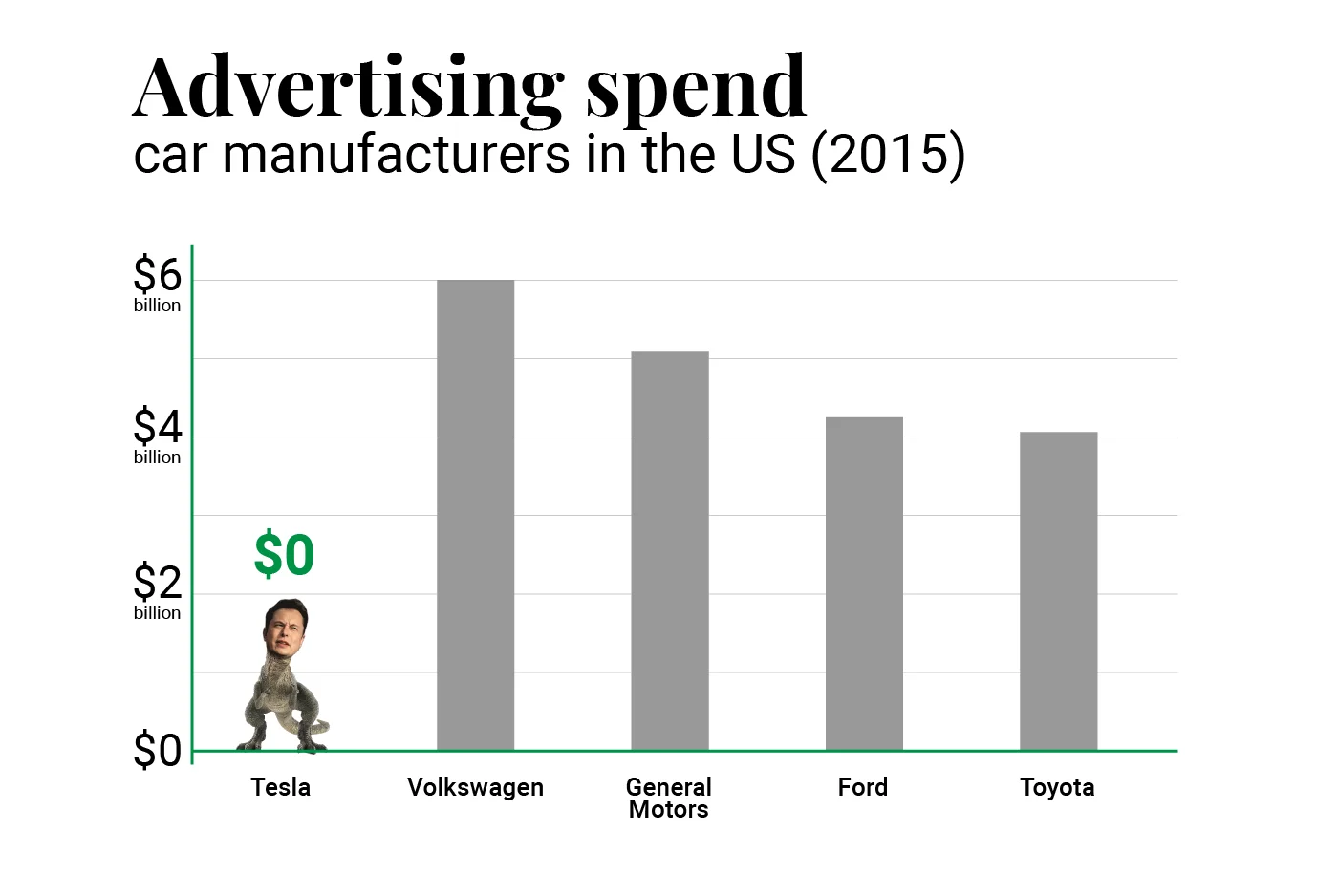
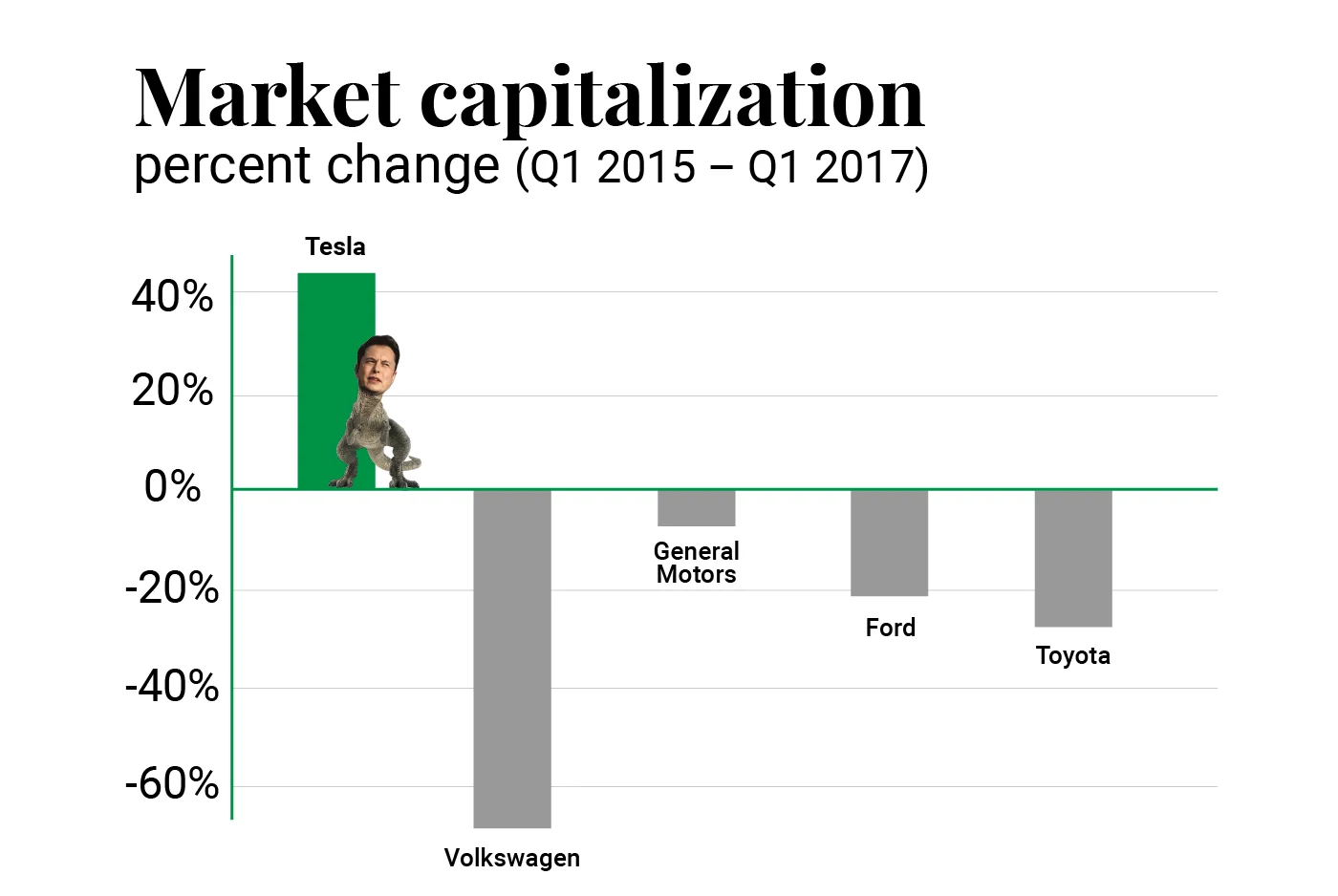
Anyone can replicate this strategy in many ways. Amazon did something similar in 2013, when they gained a lot of free media coverage thanks to “delivery drones” that were never going to happen. And politicians from all over the world get elected by making promises that later they don’t fulfill. In fact, Elon Musk himself has replicated his own strategy on multiple occasions — in ways that continue to surprise us.
After Tesla Motors, Elon Musk created a company called The Boring Company under the claim that it would build a network of underground tunnels under Los Angeles. But then he sold hats and flamethrowers instead. If you think this is a joke, please note the The Boring Company has sold 50,000 hats at $20 each (bringing in $1 million) and 20,000 flamethrowers at $500 a pop (bringing in $10,000,000).
Swag from Elon Musk’s Boring Company hits eBay for thousands of dollars. 5 Feb 2018. CNBC.
Elon Musk delivers first 1,000 flamethrowers, value rockets on eBay. June 11, 2018. USA TODAY.
And to take it even further, Elon Musk revealed his plans to launch a Tesla branded tequila in 2018 - which will surely be a source of income for the company, even if the affordable electric car that got us interested in the first place is far away from happening.
You are surely wondering: but what happens when you don’t deliver? Don’t people get disappointed or even angry at you? As it turns out, not necessarily. There are many ways of promising something and then delivering something else instead, without people getting upset about it. For instance, you may excuse yourself saying that the non-newsworthy product is a step towards achieving the newsworthy product that you are promising. This way, it doesn’t seem like you were lying, you simply failed to deliver — and that is not the same as lying.
It’s worth mentioning that for this strategy to pay off, the product that you actually deliver — instead of the newsworthy one — must be a product that people want to buy, like hats, flamethrowers, luxury cars or tequila. Otherwise, the press coverage will not translate into sales. But then again, it’s also a great tool for market validation. If you achieve great coverage for your company and then people don’t buy what you are selling, then you know that it’s not a good business.
The Blazesaurus
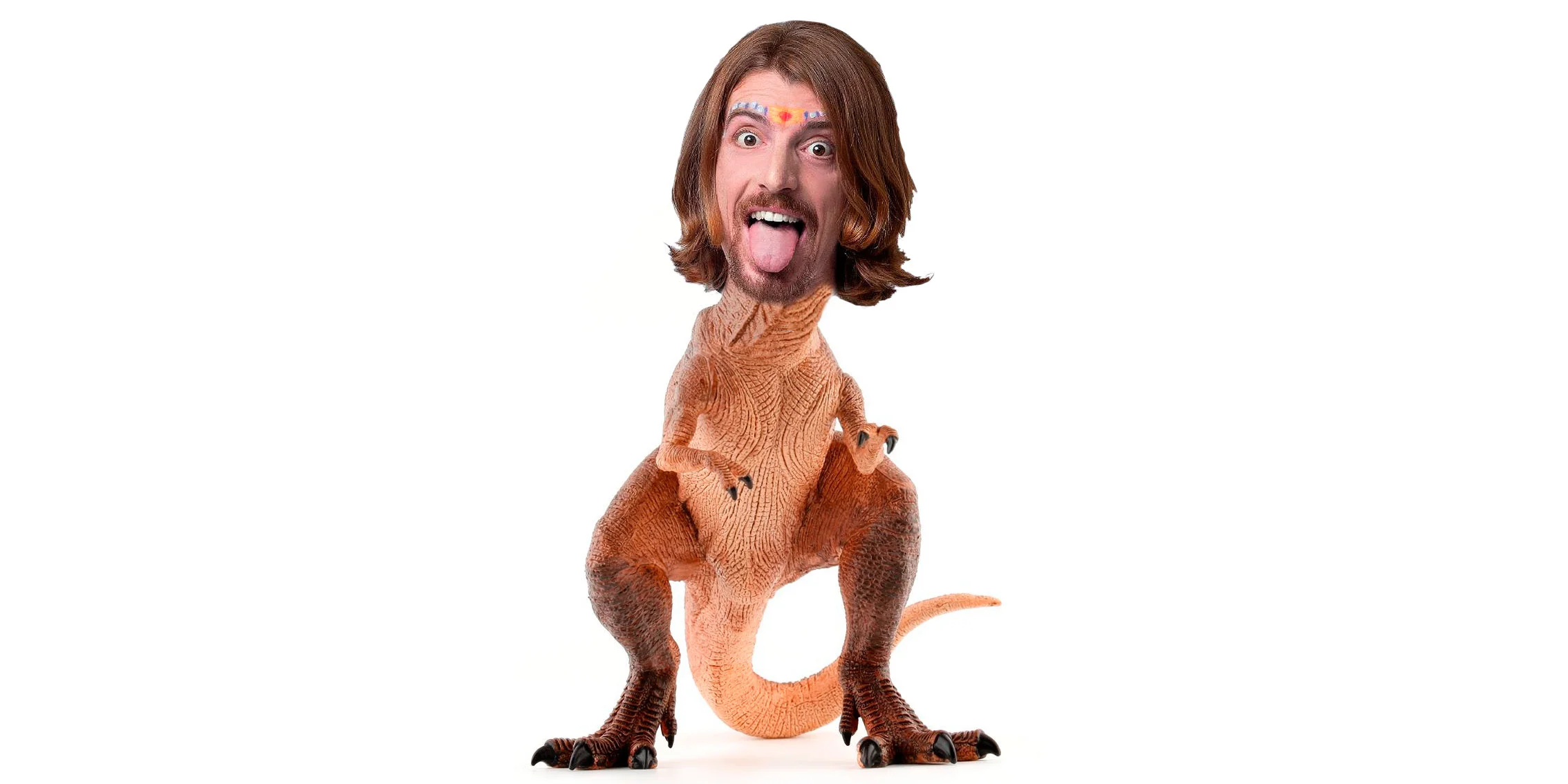
The Blazesaurus is a humble dinosaur that becomes famous and well liked for challenging bigger animals and questioning the status quo.
The specimen is named after Blaze Arizanov, co-founder of StayUncle. This Indian startup was founded by a Macedonian redhead and an Indian salesman that moved to New Delhi to promote an idea that appeared immoral, radical and controversial for India: hotels for unmarried couples. And in just three years, StayUncle expanded to more than 800 hotels, with $3.5 million in turnover and a user repetition rate above 30%.
The Blazesaurus consists of somehow challenging the status quo, and therefore creating a story that becomes newsworthy for its social implications. In India, there is a lot of hate regarding this topic. The most traditional sectors of society strongly oppose pre-marital sex. So when Blaze and his co-founder Sanchit started their company, they were flooded with hate comments and criticism. They were threatened by fundamentalists and online trolls.
You might think that this is a bad thing, but strong opposition is an awesome opportunity to become newsworthy. Indeed, the idea was controversial enough to make their company thrive with a non-existing marketing budget.
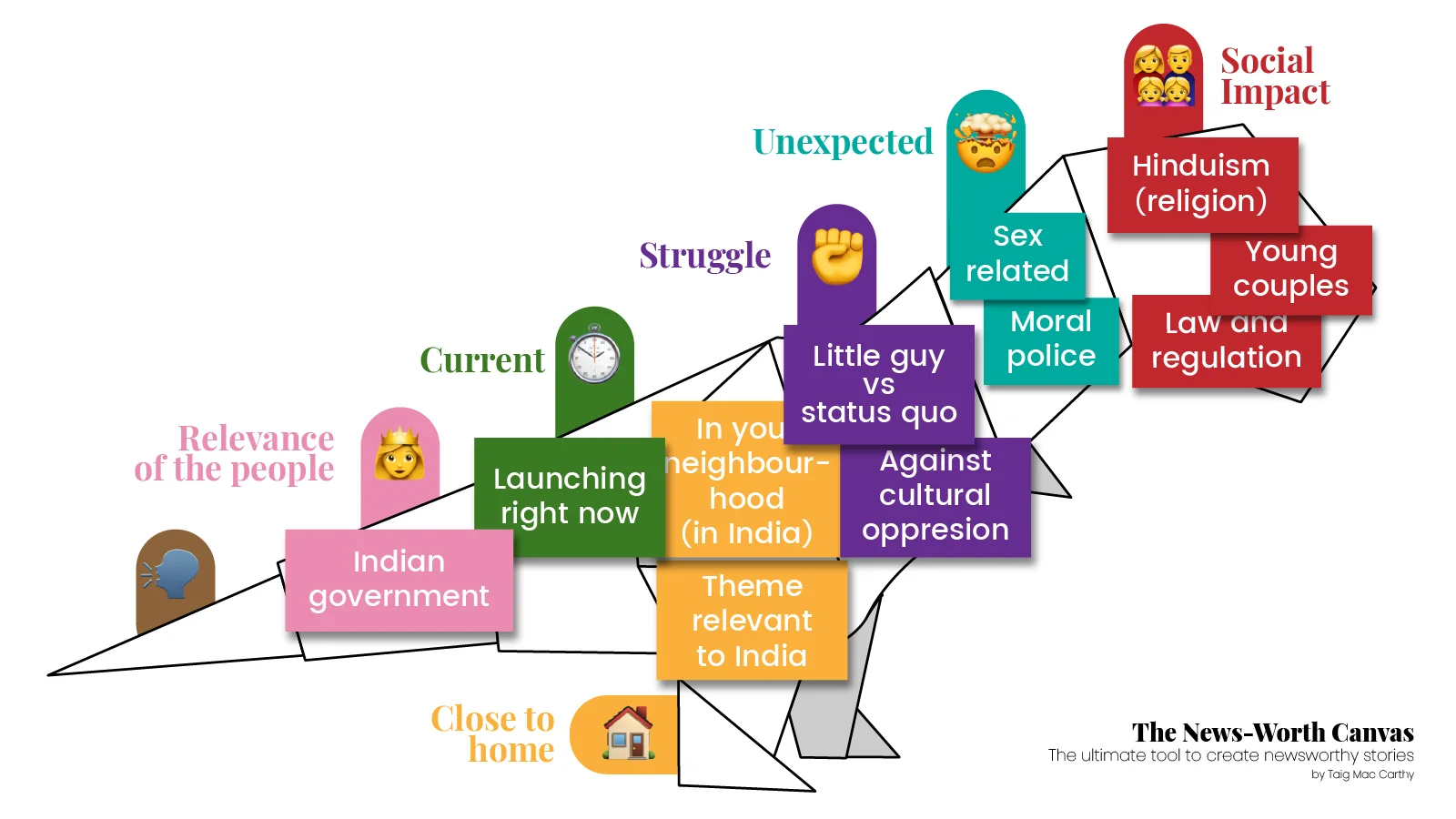
When I asked the founders what their major milestone on the path to success was, they quickly remembered April of 2016 when they “starred” for the first time in a newspaper:
According to Blaze, that was the day on which they became a business. On the same day, many Indian nationwide outlets published the story, and in the following weeks several international outlets such as; Discovery Channel or BBC called them to publish stories such as:
Hotel rooms for hire: Young lovers get a break in India. 06 Oct 2016. BBC News.
The Uncles of Good Sex. July 20 2018. VICE.
Why are unmarried couples seeking a room in hotels seen as immoral. APRIL 22 2016. The Hindu.
Before that, StayUncle only did street marketing, which is exhausting and does not provide a significant reach. But thanks to the media coverage, StayUncle grew from around 10 monthly transactions to 100, and kept doubling their metrics at that rate for 3 months.
The story of the underdog challenging the establishment falls into the narrative of David vs. Goliath, a biblical archetype that Hollywood and media outlets love exploiting. So most articles covering StayUncle’s story featured them as the hero, battling against the most traditional stakeholders of Indian society. And Blaze Arizanov sure got the hang of it.
The team decided that their whole marketing strategy would revolve around being social activists supporting progressive topics in India to get purposely into trouble as much as they could. According to the founders, the topic of rooms for unmarried couples that made them famous wore off after a while. It stopped being current. So they needed ‘another hook’. But Blaze had another controversial idea: promoting StayUncle with images featuring Indian divinities.
And as you can see by the comments, the campaign sparked off discussion, drawing love, hate and tons of attention and free clicks to their website, as well as a second wave of media coverage.
In the late 2016, StayUncle was targeted by a series of cyber attacks that made their website repeatedly go down. So they contacted journalists to let them know about the attacks, and many newspapers published stories that got them even more media attention.
For Blaze Arizanov and his team, coming up with newsworthy stories has become a process. Every 3 to 4 months they do something radical: ‘whenever StayUncle’s Google Alerts were going down, it was time to think up something new’, explained Blaze.
When we contacted Blaze and I told him about our own entrepreneurial background, he said:
It looks like angering traditionally-minded people turned out well for the both of us.
Indeed it did.
The Trumpsaurus
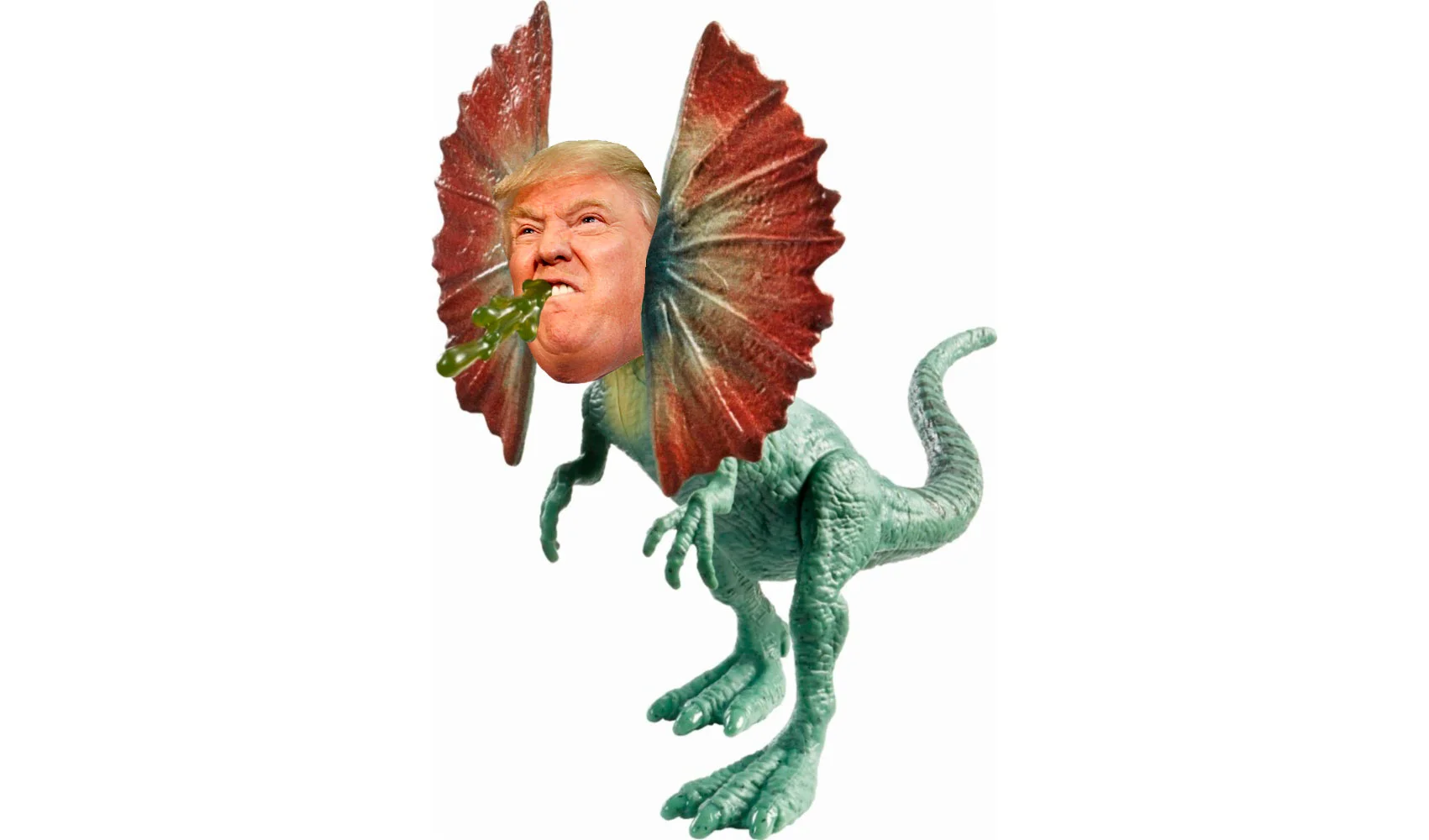
This dinosaur causes outrageous scenes to gain people’s attention and then he delivers his product, repeating this process over and over again to achieve great awareness and grow its influence.
In January of 2016, Kanye West and Wiz Khalifa had an argument on Twitter. Well, I wouldn’t really call it an argument, because Kanye was the only one tweeting. And apparently, Kanye only went off because he thought Wiz was tweeting about his wife: Kim Kardashian - and he wasn’t.
Here are some of the highlights of the discussion:




Regardless of how stupid the event was, thanks to all the media coverage, Wiz Khalifa gained 61,000 new followers on that day alone. In that same timespan, Kanye gained 172,000 followers. At the peak of the conversation, Kanye West was mentioned in 88,000 tweets PER MINUTE.
This is how the 45th President of the United States, Donald Trump, manages to stay relevant. He just says outrageous stuff that is so wild that journalists can’t help but cover it. Newspapers from all over the world published stories about Donald Trump’s crazy adventures during the presidential campaign of 2016, making his influence grow and grow.
I was not surprised to learn that Donald Trump had one of the lowest advertising budgets during his presidential campaign. He spent less on television advertising than any other major candidate, as you can see in the following chart:
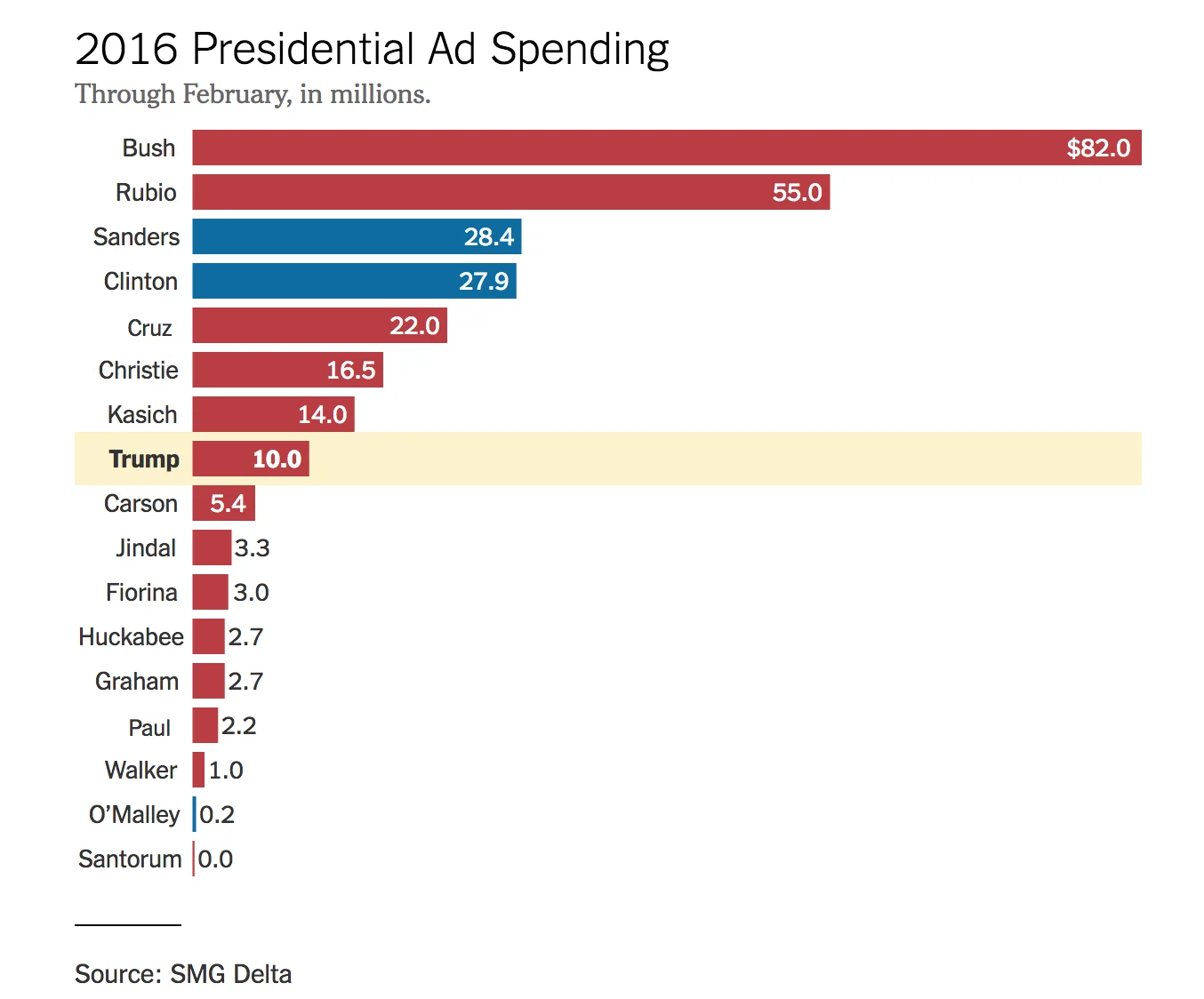
Despite his reduced budget, he earned a lot of media coverage. The chief analyst of a major media observatory said that Trump had no weakness in any of the media segments. In other words: he was strong in every type of media, from television to Twitter — and he achieved that with the lowest marketing budget. Let that thought sink in.
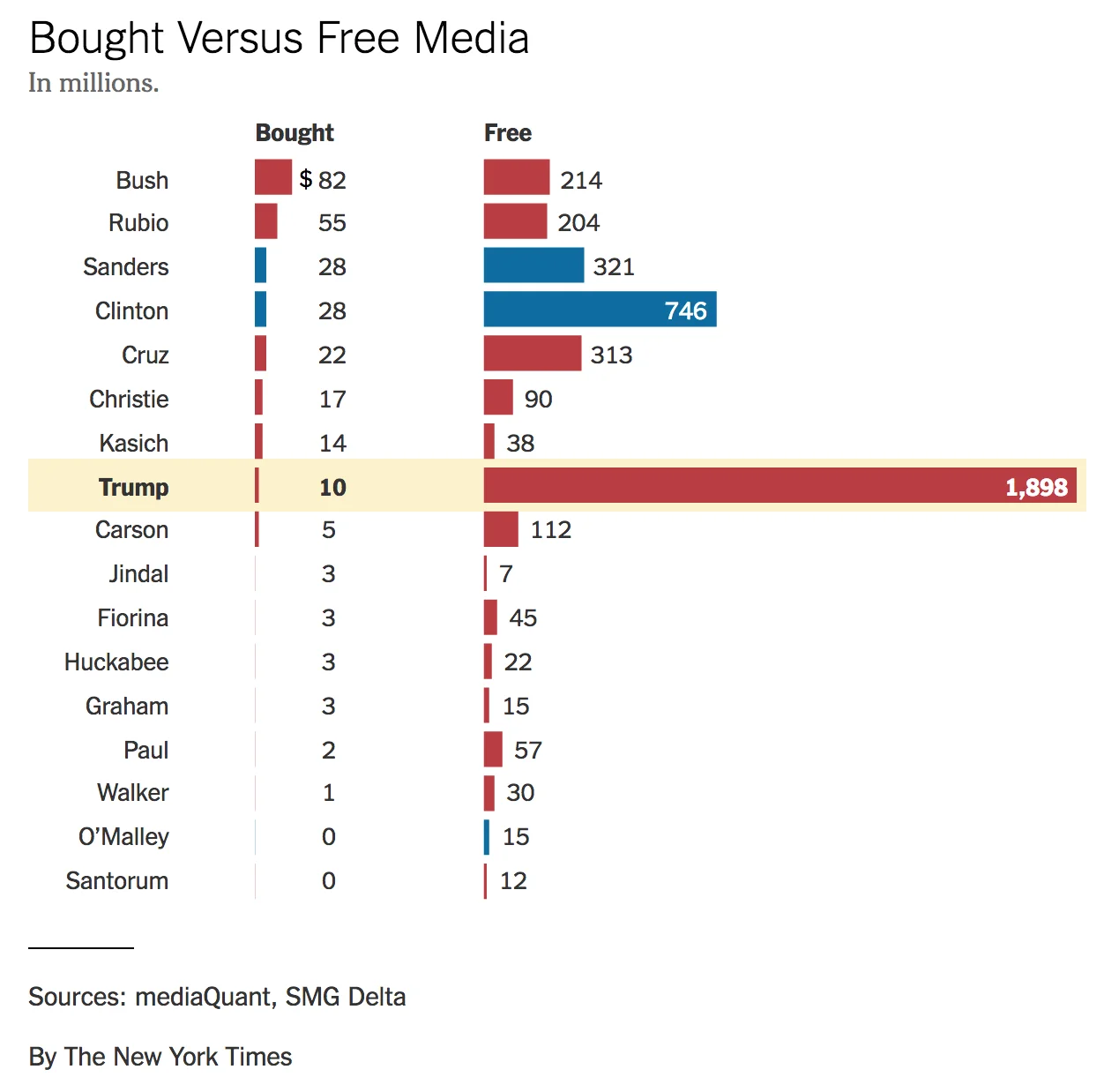
How did Trump achieve this? Through creating dinosaurs. Donald Trump is a dinosaur machine. And all his dinosaurs follow the same pattern: he involves relevant people, he takes over a topic with a broad impact and then he does something unexpected or bizarre, creating a story that also has a generous sprinkling of conflict.
Let’s analyse one of his dinosaurs with the News-Worth Canvas framework. Do you remember that time that Trump made fun of a disabled journalist during a political speech? Here is the story that The Washington Post wrote:
Meryl Streep was right. Donald Trump did mock a disabled reporter.
Now, let’s see what that story looks like when analysed through the News-Worth Canvas:
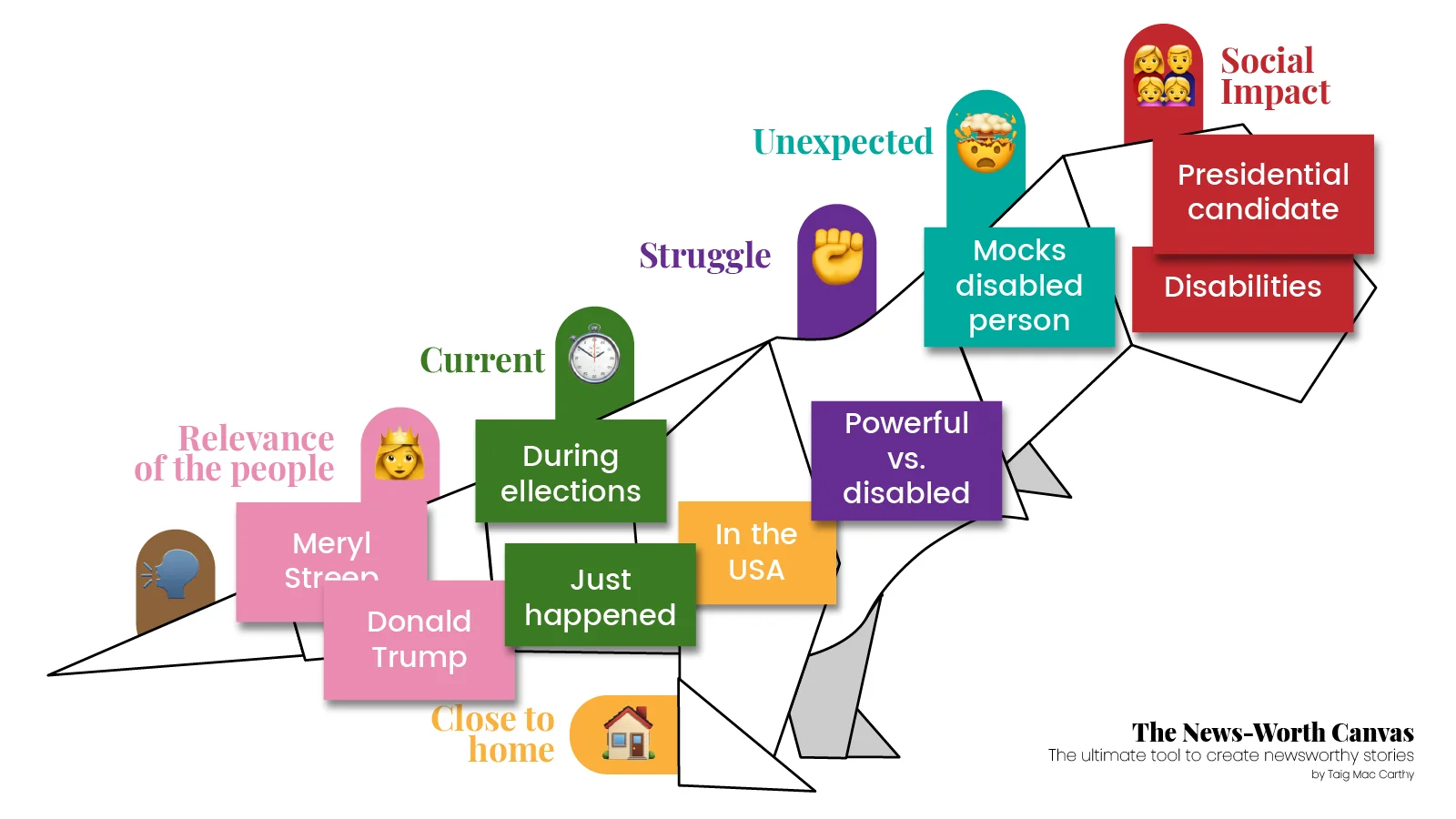
As you can see, the story hits many of the 7 Traits of News-Worth: it has broad impact since we are talking about a man that could be your next president. It involves disabilities, an issue that many people care about. It is evidently unexpected because you are not used to seeing a grown up mimicking a disabled person in front of a crowd. And it has conflict because there is a clash between a vulnerable person and a powerful presidential candidate. Plus, it involves Meryl Streep, which adds relevance to the event.
Don’t be fooled by Trump’s outrageousness — it may appear nonsensical, but it’s very strategic. Trump does crazy business to get media coverage, and he exploits the coverage by delivering his message over and over again, achieving brand awareness that would cost millions of dollars.
The story of Trump mimicking the reporter is newsworthy on all counts, and therefore every newspaper had to cover it. Some of them went even further, like The Washington Post, who added this picture to the article to make the read more compelling:

Thanks to this awful event, Trump delivered his slogan, “make America great again”, to a huge audience. When he mocked the disabled reporter, he did so from his stand at a presidential meeting, where everyone could clearly read his slogan and his supporters’ banners. Therefore, when TV channels aired the footage of Trump bullying the reporter, they were also showing his campaign’s promotional materials. Plus, you must understand that Trump’s message is not: “make America sympathetic again”. His core message is about winning. He is selling success. So bullying someone is not really something that jeopardises his message, as long as he is the bully and not the victim.
Let us clarify: we are not saying Trump’s behaviour is right. We are just offering an explanation of how he managed to become so influential whilst being the candidate with the smallest budget.
And this is just one of many examples. Remember the “grab ‘em by the pussy” video? Or that other time when he called immigrants “animals”? Or when he referred to the leader of North Korea as “short and fat little rocket man” on Twitter? All of these are awesome stories, from a public-interest point of view, and any journalist will pick up on and cover them. And by doing so, they are indirectly spreading his message. The president of CBS said, on the record, that the election of Donald Trump “may not be good for America, but it’s damn good for CBS”.
Possibly one of my favourite trumpsaurus was the one where Donald Trump and Kanye West met in the Oval Office.
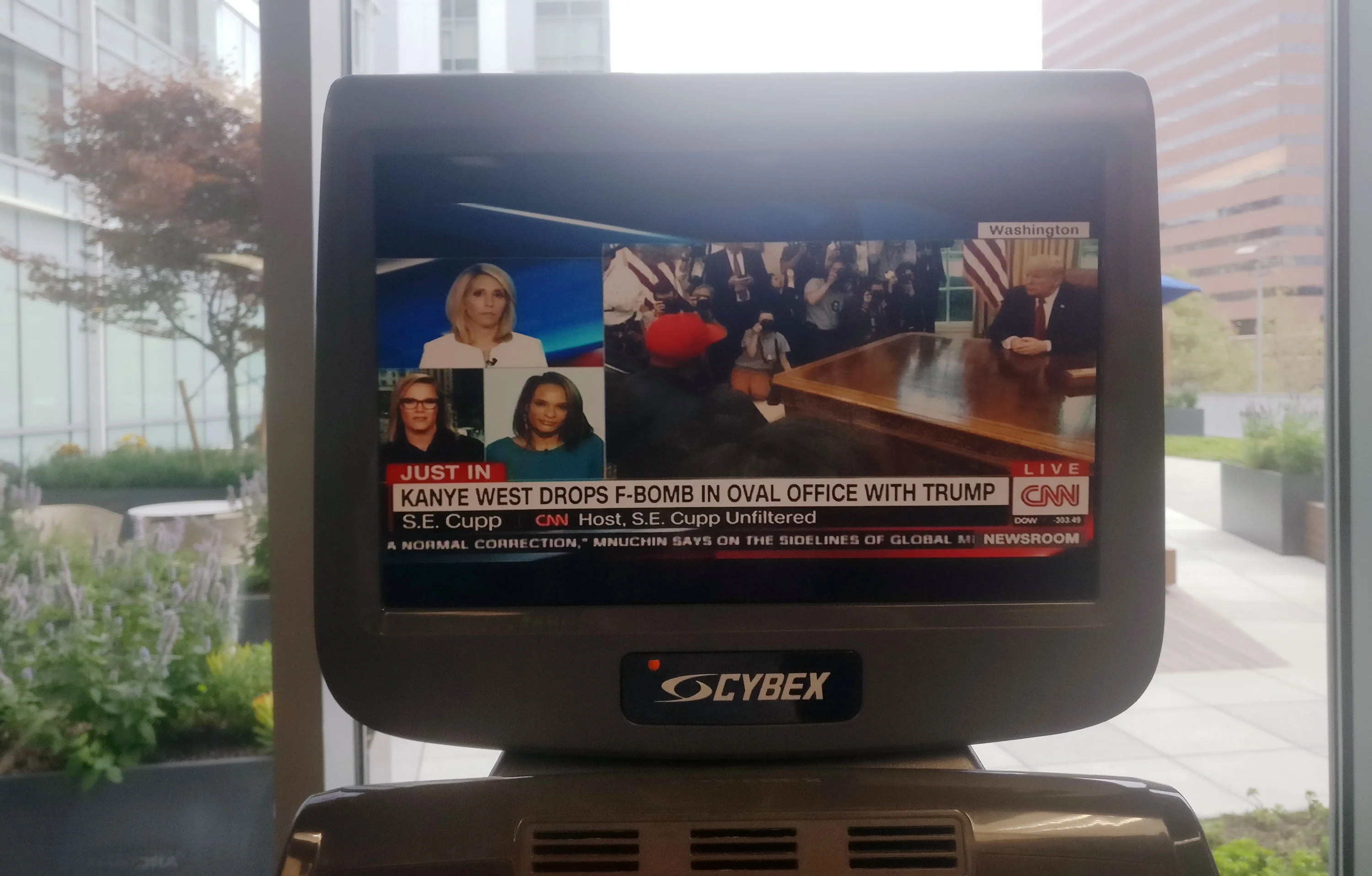
Isn’t nature something beautiful? It’s quite a rare event that two specimens of such prominence gather in the same space. Just for the fun of it, let’s take a look at the story through the News-Worth Canvas:
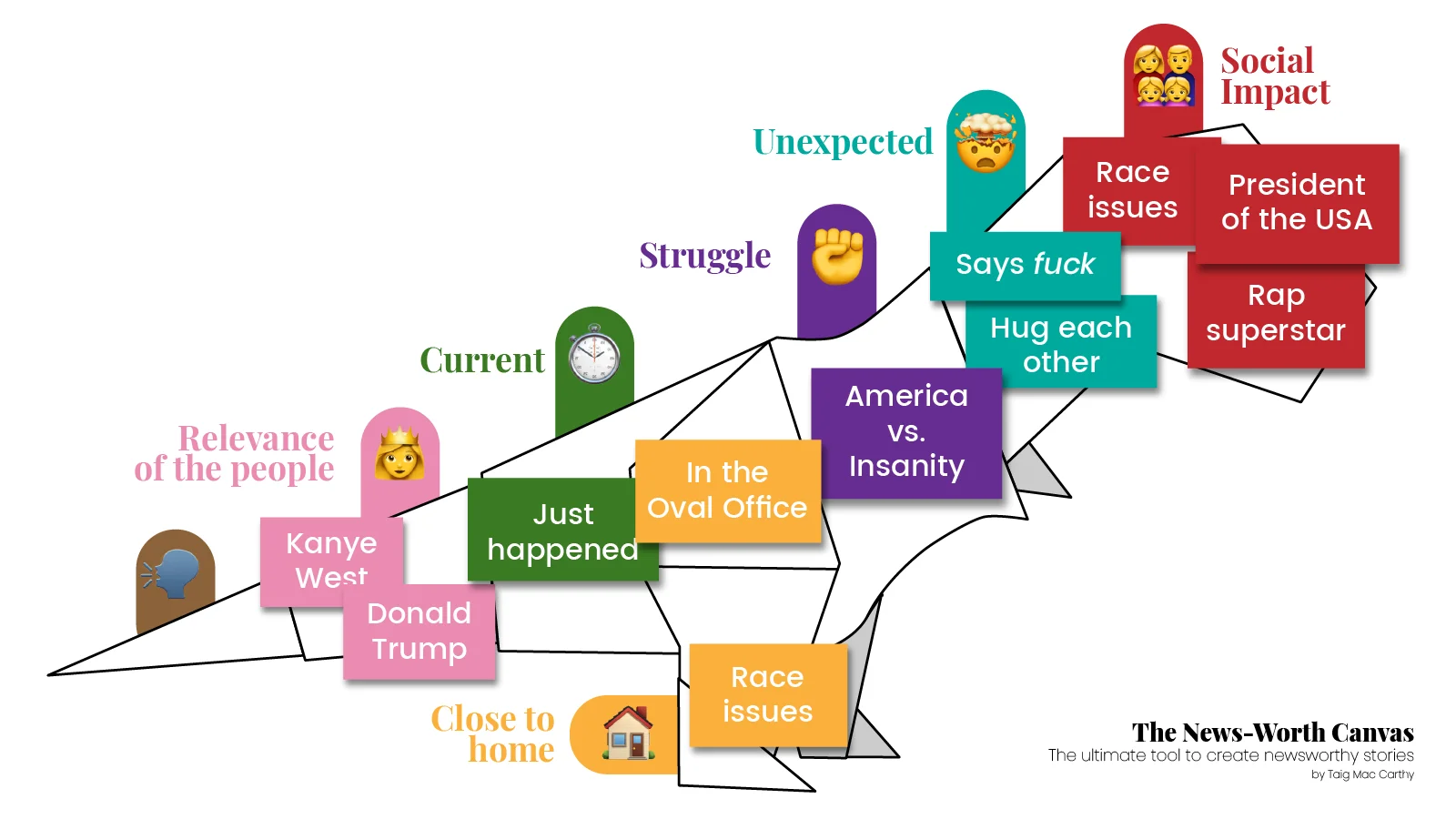
As you can see, it’s always the same pattern. This time, the unexpected element is that Kanye said fuck, that Kanye said that he “loved” Trump, that they hugged, or any of the other crazy business that happened during that meeting.
Both Kanye and Trump have great understanding of News-Worth Dynamics and they know that saying crazy stuff is a great marketing strategy. In fact, why don’t you take a look at the video of them meeting at the oval office. This is what President Trump says to Kanye at the end of the meeting, while pointing his finger at the journalists:
All over the world they’re talking about this, and I have to tell you, I had important meetings today with Senators and with everything; nobody cared. They wanted this meeting, this is the meeting, is that right? I can say that to John. No, the others were good, right? But this is what they want.
Saying outrageous things might not get you the love and the validation your heart is seeking, but it’s definitely a very cost effective strategy for spreading your influence and getting your product into the news.
If you want to learn more about Trump’s political strategies and debate tricks, I encourage you to check How Trump Manipulates The Media, a video by Charlie Houpert and Ben Altman.
The WeWorksaurus
The WeWorksaurus raises an issue with a broad impact and places itself at the center of the discussion, gaining a great amount of second-hand attention. This way, it expands its exposure from a niche to the wider audience.
We met WeWork’s General Manager, Dave McLaughlin, at an event in Babson College in 2018. He told us about WeWork’s decision to stop offering meat at company events.
WeWork goes meat-free ‘to leave a better world’. APRIL 4, 2018. REUTERS.
Global office-sharing company WeWork, which operates in 22 countries, is going meat-free and will ban staff from expensing meals containing meat in a bid to “leave a better world for future generations”.
WeWork’s decision is a great example of how you can get free media coverage by striking at the heart of an issue with a broad impact. In fact, McLaughlin told us that this was the time that WeWork gained the most press coverage they have ever had. This is quite surprising for a company valued at US $20 billion, managing 10,000,000 square feet of office space and has a big fat marketing budget with an experienced communications team. But indeed, this event turned out to be the most cost effective strategy to promote their company and engage with a very large audience.
Dave told us that the decision of ditching meat got them so much press coverage that the mainstream public suddenly knew about them. His dad, who lives in the country and doesn’t really understand WeWork’s value proposition in the startup scene, called him and asked: ‘so… I’ve heard you don’t do meat anymore’.
To understand why this works, read this headline from the New York Times and check out how it looks in the News-Worth Canvas:
Memo From the Boss: You’re a Vegetarian Now. July 16, 2018. New York Times.
Only a very small percentage of the population cares about WeWork’s co-working services. However, everyone eats: that’s 100% of the population. And the choice between eating meat and becoming a vegetarian is a very mainstream topic that most people care about. It’s even likely that you have considered it yourself or have had an argument over it. Therefore, WeWork’s involvement in this issue granted them a broad social impact that otherwise they could have never achieved. That is how they became mainstream: the issue granted them the broad impact they otherwise lacked.
As with every other social issue that has a broad impact, there was a fair share of conflict because everybody has an opinion on the matter. There were people in favour of WeWork’s decision and people against it. But the important thing is that people cared enough to have an opinion and talk about it.
The Redbulldocus
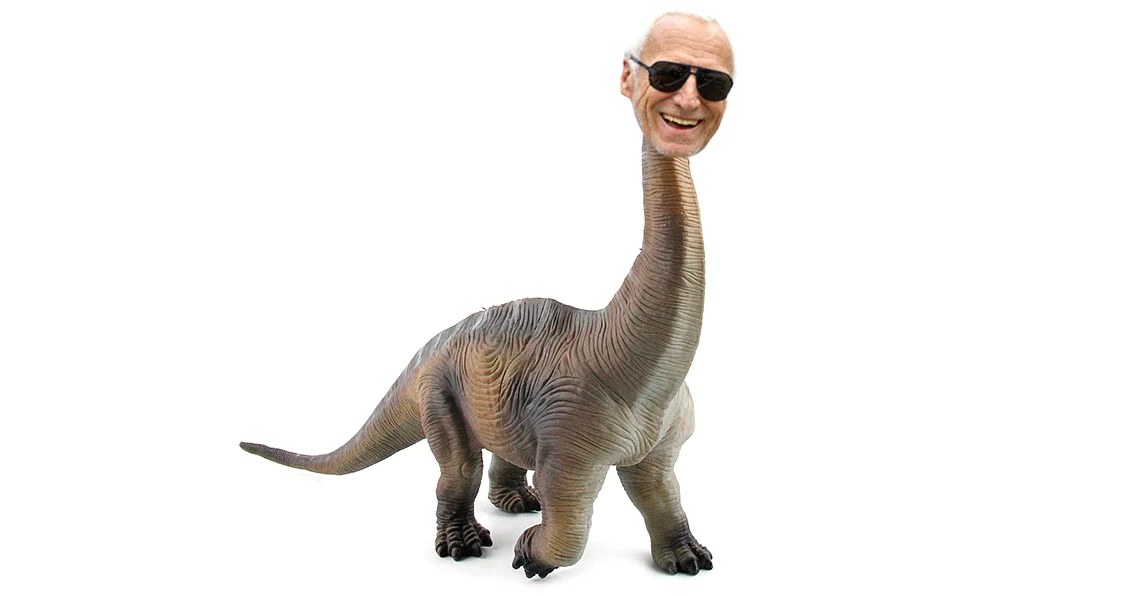
Among the biggest dinosaurs, the Redbulldocus has a tail so long that people protest about it. And thanks to the complaints, the Redbulldocus has become the most recognisable dinosaur in the reign.
This dinosaur is named after RedBull, the Austrian company that has sold 6,302 billion cans of a drink that no one cared about until they saw concerned people complaining about it on TV. The complaints featured Red Bull as a drink so potent that it could cause heart attacks. In other words: Red Bull is so good at giving you energy that you could die from an overcharge. That’s the key to the Redbulldocus’s success: being so good that it’s bad. It’s such a good bad reputation.
Each of the accusations against Red Bull’s potency became a newsworthy story in its own right that reinforced the idea that Red Bull was too good at giving you energy. Everytime authorities in countries like France or Denmark banned Red Bull from being sold domestically, the drink got tons of free media attention and international exposure. Even when someone sued Red Bull for wrongful death in the US, they ended up gaining brand awareness.
Let’s draw out the forenamed elements in the News-Worth Canvas:
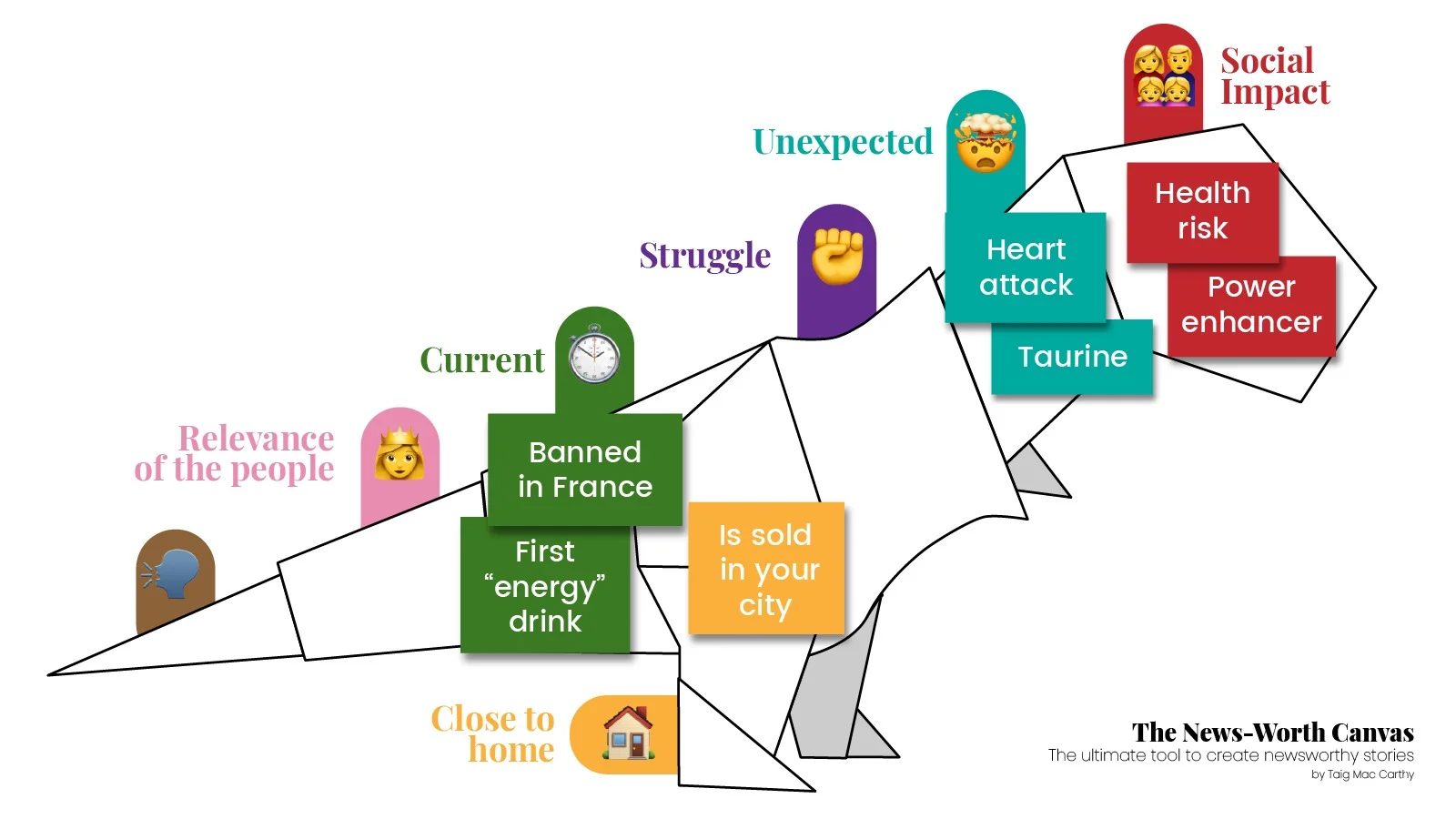
Thanks to the newsworthiness of these events, Red Bull made close to $12.5 billion in sales in 2015. The Austrian company is now a recognised global brand, which is quite astounding for such a young company that spends less than 20% of its marketing budget on paid advertisement. That is what a dinosaur does to a marketing strategy.
Surprisingly, no one has been able to prove a definite health risk in Red Bull. In fact, according to the European Food Safety Authority (EFSA), Taurine has no basis of scientific evidence to support any health claim at all. But that’s the funny thing about complaints: you have to prove the effects of your claims, but people who complain about you don’t have to prove anything at all.
Somewhere between 2008 and 2012 people stopped complaining about RedBull. Ever since, the company has performed many stunts to create newsworthy events, like making a guy jump from the stratosphere in 2012. But nothing will ever be as cheap and effective as making people complain about your potency.
A good way of introducing a RedBulldocus is saying that you are not something, because it implies that you have been accused of something, but it doesn’t require you to explicitly lie about it. If Red Bull had said: we are not killing people from an overcharge, that would have implied that people were claiming they did so. Therefore, a great way of introducing your Redbulldocus would be defending yourself from accusations in a press release, by simply stating that you are not something. This way, you will spark off a conversation that will benefit your brand awareness more than any other marketing strategy you can think of.
For example, the self-help author Tim Robins decided to name his autobiographical documentary I AM NOT YOUR GURU. Choosing that the title portrays the idea that people actually think he is indeed their guru. He does not explicitly say that he is a guru, nor does he provide proof of people calling him such a thing; but he implants the idea in people’s minds by saying he is not it.
The Ashleyraptor
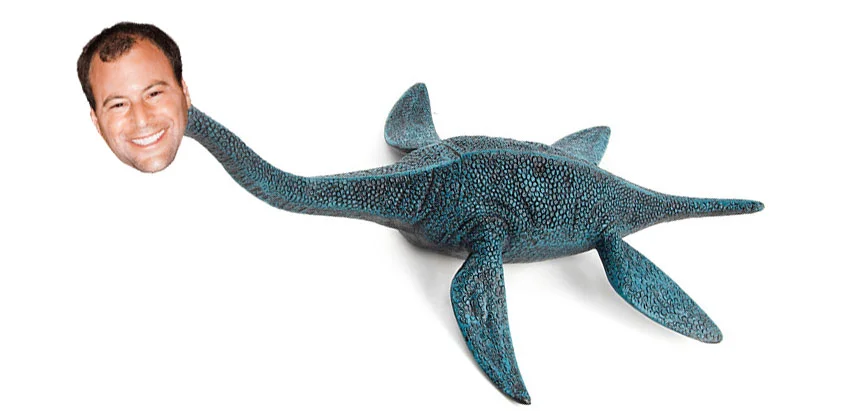
The Ashleyraptor serves as an answer to a question that we frequently ask ourselves: what is the worst thing that could happen? If a dinosaur could ever could go wrong, this is the one. The Ashleyraptor is a dinosaur so dreadful and shocking that it becomes very well known and influential.
The specimen is named after Ashley Madison, a website that enables extramarital affairs. This Canadian company has one job: discretion. And they enormously failed at that some years ago.
The first time we heard of Ashley Madison’s existence was in July 2015, when hackers stole users’ data from the company servers. The hackers got hold of personal information off the site’s user base and threatened to release users’ names and personally identifying information unless Ashley Madison immediately shut down.
By definition, a dinosaur is a story that turns your company into a newsworthy event. And there is no question that this is one hell of a dinosaur. This event, disastrous though it may be, enabled Ashley Madison to be in the spotlight on a global scale and gain a huge amount of brand awareness without allocating a single dollar to paid marketing.
Let’s be clear: we are not recommending you to breach your customers’ data to get media coverage. This is a terrible, terrible idea. We are just saying that it would be a newsworthy event, and that it wouldn’t necessarily put you out of business.
The Uberdocus
Back in 2013, no one knew about Uber in Spain. But the American company had plans to conquer the Mediterranean market before any of its competitors. To achieve their goal, Uber chose to enter the Iberian peninsula through Barcelona by stirring up a hornet’s nest.
Barcelona is a great city for ride-sharing apps, since it hosts millions of tourists that move around the inner city every day of the year. But it is also home of the highly regulated and very lucrative taxi sector that many families depend on.
Just one month into Uber’s operations in Barcelona, hundreds of taxi drivers came together to organise a strike in the streets of the city. The event was so intense that people were hurt during the protests. This event hits many of the 7 Traits of News-Worth, and it got a lot of media coverage.
Two injured in the protests of Barcelona taxi drivers against Uber. 2014/06/11. El País.
The protest alone turned Uber from a total stranger into a recognisable brand that people talked about in Spain, achieving a level of awareness that otherwise would have been very costly. And the awareness quickly translated into sales: during the week of the protest, Uber’s app became the third most downloaded iPhone app in the country — without a single euro spent on marketing.
This is a good example of how a foreign entity can turn itself into something that is Close to Home. The strike in Barcelona was a very local event, so even if Uber is not a local company at all, they became a newsworthy entity. And this strategy has been replicated by Uber in many cities all over the world, so it is as scalable as any other marketing strategy.
The Vicesaurus
The Vicesaurus is a specimen known to have a very bad influence over others, and therefore becoming very popular. It is name after the video game Grand Theft Auto: Vice City, that came out in 2002 and changed the gaming industry forever due to its violent and explicit content.
This video game is yet another example of the power of dinosaurs. Within two days of its release, Vice City sold 1.4 million copies, making it the fastest-selling game in history at the time. By March 2008, the game had sold 17.5 million units worldwide.
Most teenagers came to know of the game because they saw it on the news channel. Apparently, it was so violent, realistic and addictive that it would turn a whole generation into serial killers.
Think about it: without investing a single dollar, grandmothers in Alabama were talking about a video game, back in 2002. Try achieving the same result with paid advertising. It would be impossible. That is the power of dinosaurs.
The key, as with the Redbullsaurus, is making people hate what other people actually enjoy about your product. With Vice City, the game was so violent and addictive that you could become a serial killer. And that’s exactly why people wanted to buy it. Every complaint against the game was also a compliment towards their value proposition.